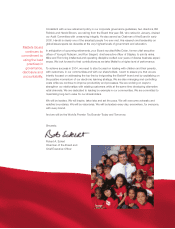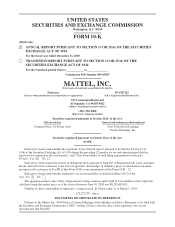Mattel 2003 Annual Report Download - page 18
Download and view the complete annual report
Please find page 18 of the 2003 Mattel annual report below. You can navigate through the pages in the report by either clicking on the pages listed below, or by using the keyword search tool below to find specific information within the annual report.Financial Instruments
Currency exchange rate fluctuations may impact Mattel’s results of operations and cash flows. Mattel seeks
to mitigate its exposure to market risk by monitoring its currency exchange exposure for the year and partially or
fully hedging such exposure using foreign currency forward exchange and option contracts primarily to hedge its
purchase and sale of inventory and other intercompany transactions denominated in foreign currencies. These
contracts generally have maturity dates of up to 18 months. In addition, Mattel manages its exposure through the
selection of currencies used for international borrowings and intercompany invoicing. Mattel’s results of
operations can also be affected by the translation of foreign revenues and earnings into US dollars. Mattel does
not trade in financial instruments for speculative purposes.
For additional information regarding foreign currency contracts, see “International Segment” above, Item
7A “Quantitative and Qualitative Disclosures About Market Risk” and Item 8 “Financial Statements and
Supplementary Data—Note 8 to the Consolidated Financial Statements.”
Seasonal Financing
Mattel’s financing of seasonal working capital typically grows throughout the first half of the year and
peaks in the third or fourth quarter, when inventories are at their highest levels in anticipation of expected second
half sales volume and when accounts receivable are at their highest levels due to increased sales volume,
consistent with the industry taken as a whole. See “Seasonality.” Mattel expects to finance its seasonal working
capital requirements for 2004 by using existing and internally generated cash, issuing commercial paper, selling
certain trade receivables, and using various short-term bank lines of credit. In addition, Mattel avails itself of
individual short-term foreign credit lines with a number of banks, which will be used as needed to finance the
seasonal working capital requirements of certain foreign subsidiaries.
In March 2002, Mattel amended and restated its existing domestic unsecured committed revolving credit
facility into a $1.06 billion, 3-year facility with an expiration date in 2005. In March 2004, Mattel anticipates
amending and restating its domestic unsecured committed revolving credit facility. The size of the facility is
expected to be changed to $1.30 billion, and the expiration date of the facility is expected to be extended to
March 2007. The other terms and conditions of the amended and restated facility are expected to be substantially
similar to those currently in place. Mattel’s domestic unsecured credit facility contains a variety of covenants,
including financial covenants that require Mattel to maintain certain consolidated debt-to-capital and interest
coverage ratios. Specifically, Mattel is required to meet these financial covenant ratios at the end of each fiscal
quarter and fiscal year. The credit agreement for the domestic unsecured credit facility specifies the formulae to
be used in calculating the ratios. Mattel was in compliance with such covenants at the end of each fiscal quarter
and fiscal year in 2003. As of year end 2003, Mattel’s consolidated debt-to-capital ratio, as calculated per the
terms of the credit agreement, was 0.30 to 1 (compared to a maximum allowed of 0.50 to 1) and Mattel’s interest
coverage ratio was 12.47 to 1 (compared to a minimum allowed of 3.50 to 1). See Item 7 “Management’s
Discussion and Analysis of Financial Condition and Results of Operations—Liquidity and Capital Resources—
Seasonal Financing” and Item 8 “Financial Statements and Supplementary Data—Note 5 to the Consolidated
Financial Statements.”
To finance seasonal working capital requirements of certain foreign subsidiaries, Mattel avails itself of
individual short-term foreign credit lines with a number of banks. As of year end 2003, Mattel’s foreign credit
lines total approximately $320 million, a portion of which are used to support letters of credit. Mattel expects to
extend these credit lines throughout 2004.
Mattel believes its cash on hand at the beginning of 2004, amounts available under its domestic unsecured
committed revolving credit facility, its uncommitted money market facility, and its foreign credit lines will be
adequate to meet its seasonal financing requirements for 2004.
9
























